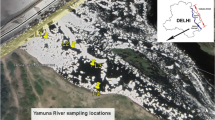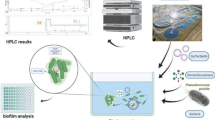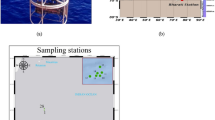Abstract
Sodium dodecyl sulphate, (SDS) is an anionic surfactant that widely used all over the world. They will eventually end-up and accumulate in household or industrial sewage. Due to their high foaming capabilities, which can cause numerous problems in sewage treatment facilities as well as direct toxic effects on many different organisms in ecosystem; they are generally considered as serious pollutants. In this survey, two different bacteria were isolated from Tehran municipal activated sludge. Biochemical tests as well as 16S rRNA gene sequencing for identification have been applied. After experiments to optimize the pH and temperature for growth of the two bacterial isolates, the extent of SDS utilization was evaluated by HPLC method. Two bacterial isolates show which ability to rapidly and actively degrade SDS upon using it as their sole source of carbon. The identification tests have indicated the two isolates to be Acinetobacter johnsoni and Pseudomonas beteli. The Pseudomonas beteli and Acinetobacter johnsoni isolates were able to degrade 97.2% and 96.4% of the original SDS levels after 10 days of growth; respectively. Mixed culture of the two isolates did not significantly increase SDS utilization, (97.6%). In conclusion, the results of this study suggest that growth of simple bacteria such as Acinetobacter or Pseudomonas in household and industrial sewage can be cost-effective method anionic surfactants elimination.
Similar content being viewed by others
References
Cain, R.B., (1981). Microbial degrading of surfactants and builder components in microbial degradation of xenobiotics and recalcitrant compounds. In, The prokaryotes., (Balows, H. Truper, M. and Dworkin, W., Eds.), Springer-Verlag, Berlin, Germany. 2625–2637.
Dhuiib, A., Hamad, N., Hassairi I., (2003) Degradation of anionic surfactants by Citrobacter braakii. Proc. Biochem., 38, 1245–1250.
Di Corcia, A., Samperi, R., Marcomini, A., (1994) Monitoring aromatic surfactants and their biodegradation intermediates in raw and treated sewages by solid-phase extraction and liquid chromatography. Environ. Sci. Technol., 28, 850–858.
Eichhorn, P., Rodriguez, S.V., Baumann, W., Knepper, T., (2002). Incomplete degradation of SDS in Brazilian surface waters and pursuit of their polar metabolites in drinking waters., Sci. Environ., 284, 123–134.
Hayashi, K., (1975). A rapid determination of sodium dodecyl sulfate with methylene blue., Anal. Biochem., 67, 503–506.
Jerabkova, H., Blanka, K. and Nahlik, J., (1999). Biofilm of Pseudomonas C12B on glass support as catalytic agent for continuous SDS removal., Int. Biodeteriorat. Biodegradat., 44, 233–241.
Jimenez, L., Breen, A., Thomas, N., (1991). Mineralization of linear alkylbenzene sulfonate by a four-member aerobic bacterial consortium., Appl. Environ. Microbiol., 57, 1566–1569.
Juker, F., Leisinger, T., Cook, A.M., (1994). 3-Sulphocatechol 2,3dioxygenase and others in the degradative pathways of 2-aminobenzenesulphonic and 4-toluenesulphonic acids in Alcaligenes SP. Microbiol., 140, 1713–1722.
Kertesz, A., Kolbener, P., Stockinger, H., Beil, S., (1994) Desulfonation of linear alkylbenzene sulfonate and related compounds by bacteria., Appl. Environ. Microbiol., 60, 2296–2303.
Laue, I. I., Field, J.A., Cook, A.M., (1996). Bacterial disulfonation of the ethanesulfonate metabolite of the choloracetanilide herbicide metazachlor., Environ. Sci. Technol., 30, 1129–1132.
Schleheck, D., Dong, W., Denger, K., (2000). An Alphaproteobacterium converts linear alkylbenzenesulfonate into sulfophenylcarboxylates and linear alkyldiphenyletherdisulfonate surfactants into sulfodiphenylethercarboxylates., Appl. Environ. Microb., 66, 1911–1916.
Schleheck, D., Lechner, M., Schonenberger, R., (2003). Desulfonation of the disufodiphenylethercarboxylates from alkyldiphenyletherdisulfonate surfactants., Appl. Environ. Microb., 69, 938–944.
Schulz, S., Dong, U., (2000). Enantimeric degradation of 2-,(4-sulfophenyl) butyrate via 4-sulfocatechol in Delftia acidovorance SPB1., Appl. Environ. Microb., 66, 1905–1910.
Sigoillot, J.C., Nguyen, M., (1992). Complete oxidation of linear alkyl benzene sulfonate bacterial communities selected from coastal seawater., Appl. Environ. Microb., 58, 1308–1312.
Sigoillot, J.C., Nguyen, M., (1990). Isolation and characterization of surfactants degrading bacteria in a marine environment., FEMS Microbol. Ecol., 73, 59–68.
Author information
Authors and Affiliations
Corresponding author
Rights and permissions
About this article
Cite this article
Hosseini, F., Malekzadeh, F., Amirmozafari, N. et al. Biodegradation of anionic surfactants by isolated bacteria from activated sludge. Int. J. Environ. Sci. Technol. 4, 127–132 (2007). https://doi.org/10.1007/BF03325970
Received:
Revised:
Accepted:
Published:
Issue Date:
DOI: https://doi.org/10.1007/BF03325970




